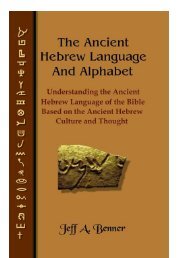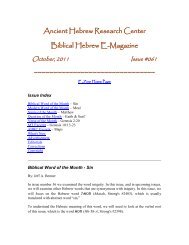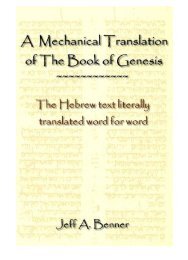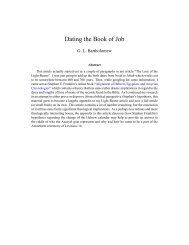My Name Forever - Ancient Hebrew Research Center
My Name Forever - Ancient Hebrew Research Center
My Name Forever - Ancient Hebrew Research Center
Create successful ePaper yourself
Turn your PDF publications into a flip-book with our unique Google optimized e-Paper software.
<strong>My</strong> <strong>Name</strong> <strong>Forever</strong> 14<br />
42. It has already been shown that the common language of Israel during the time of Josephus was<br />
<strong>Hebrew</strong>. The comment about the “Four vowels,” then, was originally expressed in <strong>Hebrew</strong>. The only<br />
thing left of The Jewish War in that tongue is said to be a “pseudepigraphic medieval <strong>Hebrew</strong><br />
paraphrase...” 45 It would not surprise me one bit to find the <strong>Hebrew</strong> of that document to be written in a<br />
distinctive, Mishnaic <strong>Hebrew</strong> style. Perhaps closer scrutiny would reveal it to be a bona-fide copy of the<br />
original and not from medieval times at all. For now, though, we must be content with the concept that<br />
the words, “Four vowels,” is an English translation of a Greek translation of a <strong>Hebrew</strong> original which we<br />
do not have. The translation is at best, second hand. It leaves us English-speakers with problems on<br />
several fronts.<br />
43. First, though it is true, as was pointed out earlier, that Hei v, Vav u, and Yud h are known as<br />
“vowel-letters,” it is not true they are always vowels. It would be accurate to say that in a language of<br />
consonants, such as <strong>Hebrew</strong>, they can double as vowels. And when they do, they are always preceded by<br />
a consonant. The consonants are said to be “vowel carriers.” Vowels do not stand by themselves. It is,<br />
therefore, quite impossible for the Yud h of vuvh to be a vowel. It must be a consonant. The “Four<br />
vowels,” for this reason, cannot be four vowels.<br />
44. Secondly, there is no such thing as a <strong>Hebrew</strong> verb comprised solely of vowels. It is the prescribed<br />
modification of consonants and vowels which colors the verbal root with the various shades of meaning<br />
necessary for successful communication. For this reason also, the “Four vowels” cannot be four vowels.<br />
45. Thirdly, it is precisely this modification of the <strong>Hebrew</strong> verb which not only leads us away from<br />
the concept of the “Four vowels” being pronounced as four vowels, but mitigates against the use of<br />
Yahweh as a valid verbal form of any kind. The <strong>Hebrew</strong> verb is conjugated or "built" in seven different<br />
ways. Each conjugation carries a slightly different nuance of meaning. In simplified form they are as<br />
follows:<br />
1. Pa’al (Kal) - Simple<br />
2. Niph’al - Simple Passive<br />
3. Pi’el - Intensive<br />
4. Pu’al - Intensive Passive<br />
5. Hiph’il - Causative<br />
6. Hoph’al - Causative Passive<br />
7. Hitpa’el - Intensive Reflexive<br />
46. Each conjugation has its own peculiar vowel patterns for the perfect (past), imperfect (future),<br />
and present tenses. Each conjugation, with its corresponding vowel patterns, modifies the simple, root<br />
meaning of the verb, conveying a slightly different nuance of meaning. 46 Not all verbs use all seven<br />
conjugations.<br />
45 http://www.preteristarchive.com/JewishWars/<br />
46 See Table 3 at the end of this article for an example.






